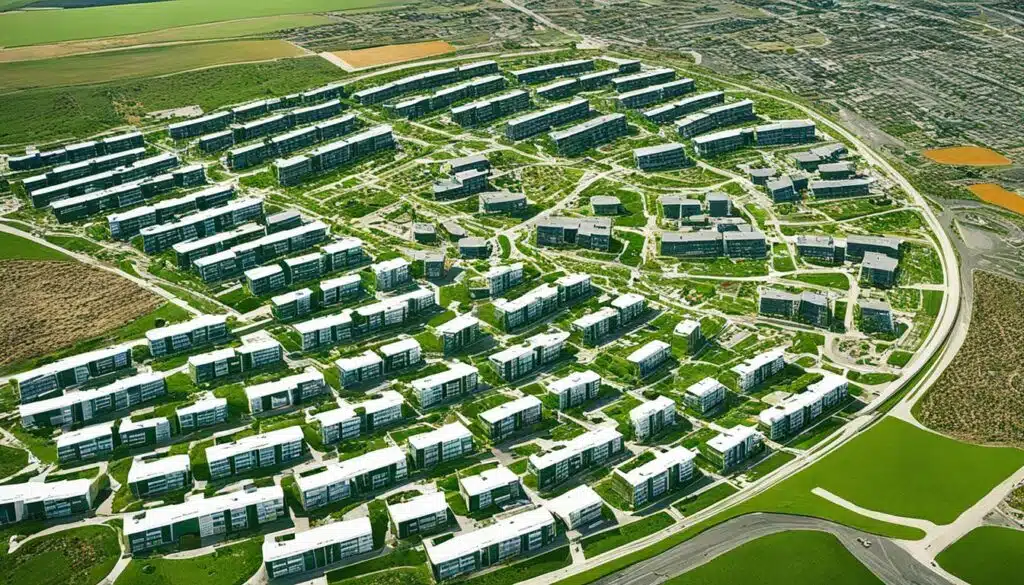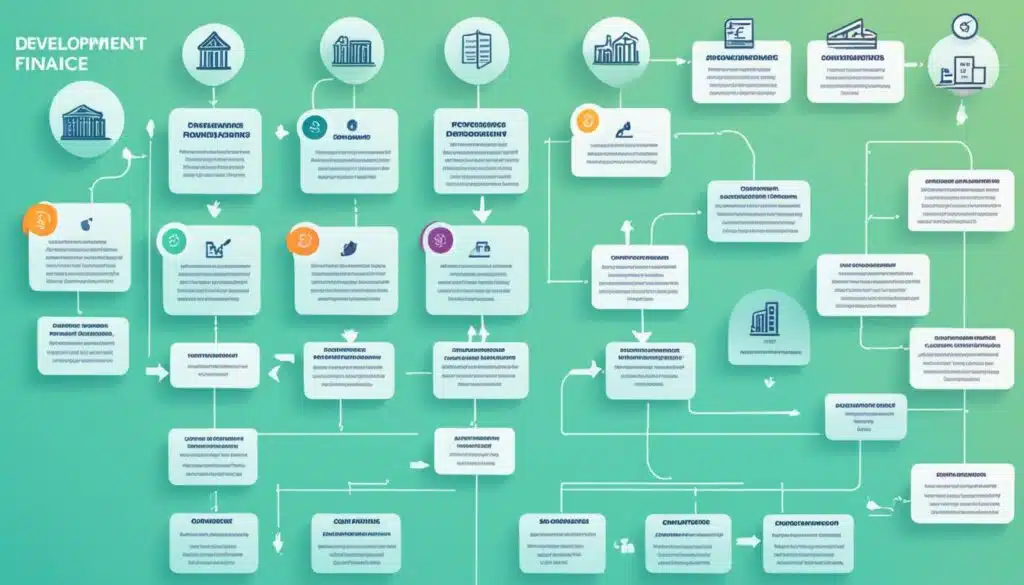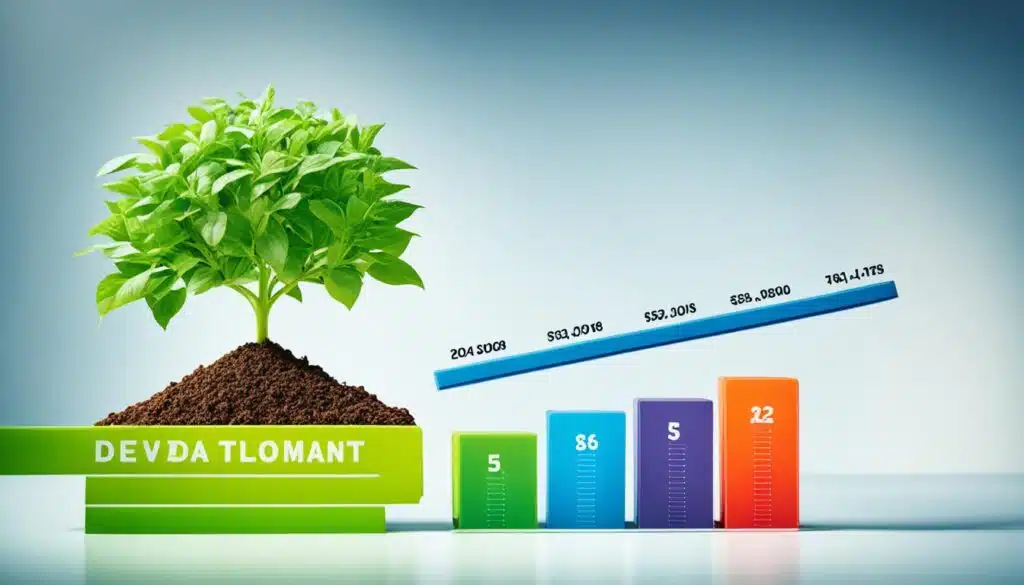Development finance plays a crucial role in funding property development projects. Whether you’re a residential or commercial developer, securing the right financing option is essential to ensure the successful completion of your development project. In this article, we will explore the ins and outs of development finance, including property development finance, development loans, and various finance options available.
Development finance refers to the funding provided for the development or refurbishment of commercial, residential, or mixed-use properties. It is a short-term lending solution, typically lasting 3-36 months, that covers the duration of the development project. The loan is expected to be repaid once the project is completed, either through the sale of the property or refinancing. There are various sources of development finance, including different types of capital such as equity and debt.
Key Takeaways:
- Development finance is crucial for funding property development projects.
- It provides short-term funding for the duration of the development project.
- Sources of development finance include equity and debt.
- There are different types of development projects, including ground-up developments, refurbishments, and land purchases.
- Lenders consider various criteria when deciding whether to provide development finance, such as the gross development value, loan to cost ratio, and exit strategy.
Sources of Development Finance
Development finance can come from various sources, with different types of capital arranged in a priority order known as the “capital stack.” The two main types of capital are equity and debt. Equity represents ownership in the asset, while debt is a loan secured against the asset or other assets of the equity owner.
Senior debt is at the forefront of the capital stack, with the first right to receive repayment. Mezzanine debt is second-tier debt and sits behind senior debt. Preferred equity offers flexible options, ranging from fixed coupon rates to sharing project upside. Common equity is the riskiest form of funding but offers the potential for higher returns.
Understanding the capital stack is essential for developers seeking development finance. By strategically combining various forms of capital, developers can create a strong financing structure for their projects.
Sources of Development Finance – Capital Stack
| Type of Capital | Description |
|---|---|
| Senior Debt | First-tier debt with priority repayment rights |
| Mezzanine Debt | Second-tier debt, sitting behind senior debt |
| Preferred Equity | Equity with flexible options, including fixed coupon rates and project upside sharing |
| Common Equity | Riskiest form of funding but offers potential for higher returns |
Each type of capital in the capital stack serves a specific purpose and carries different levels of risk and return. Senior debt provides stability and security, while mezzanine debt offers additional funding options. Preferred equity allows for flexibility in financing terms, and common equity carries the highest risk but the potential for higher rewards.
Developers must carefully consider the capital stack and make informed decisions based on their project requirements, risk appetite, and financial goals.
Also Read :Quick Cash Solutions At The Money Shop
Types of Development Projects

Development finance can be used for a wide range of projects, including ground-up developments, permitted developments, refurbishments, land purchases, and pre-construction enhancements.
Ground-up development refers to new construction projects where a building is developed from scratch on vacant land. This type of project involves designing and constructing a property according to specific requirements and regulations.
Permitted development projects, on the other hand, are projects that do not require full planning permission. These projects fall within permitted development rights, allowing certain alterations, extensions, or change of use without the need for formal approval.
Refurbishment projects involve renovating or improving existing buildings. This can include upgrading outdated properties, converting commercial spaces into residential units, or revitalizing historic buildings.
Land purchases are also common development projects. Developers acquire land with the intention of developing it into residential, commercial, or mixed-use properties. Development finance can help fund the acquisition of land to kickstart the project.
Pre-construction enhancements involve activities carried out before construction begins, such as site preparation, demolition, or infrastructure development. These enhancements are essential for a smooth construction process and can be financed through development loans.
Each type of development project comes with its own unique financing requirements and considerations. Whether it’s starting from scratch, leveraging permitted development rights, refurbishing existing properties, purchasing land, or preparing for construction, development finance offers solutions tailored to meet the specific needs of different projects.
| Types of Development Projects | Description |
|---|---|
| Ground-up Development | New construction projects developed from vacant land. |
| Permitted Development | Projects that don’t require full planning permission. |
| Refurbishment | Renovating or improving existing buildings. |
| Land Purchase | Acquiring land for future development. |
| Pre-construction Enhancements | Activities carried out before construction begins. |
Criteria Used by Lenders in Making a Decision
Lenders consider several criteria when evaluating whether to provide development finance. These factors play a crucial role in assessing the potential success and risk associated with a development project. The key criteria include:
- Gross Development Value (GDV): Lenders assess the projected gross development value, which refers to the estimated future value of the property once the development is complete. This value serves as an indicator of the potential profitability and viability of the project.
- Loan to Cost (LTC): The loan to cost ratio compares the loan amount to the total project cost. Lenders typically prefer a lower LTC ratio as it indicates a lower level of borrowing risk and a greater level of equity investment by the developer.
- Exit Strategy: Lenders carefully evaluate the borrower’s exit strategy, which outlines how the loan will be repaid. This strategy may include selling the property, refinancing, or other means of generating the necessary funds for loan repayment.
- Developer Experience: The experience and track record of the developer are crucial considerations for lenders. Developers with a proven history of successful projects and industry expertise are viewed as more reliable and capable of delivering successful outcomes.
- Financial Strength: Lenders analyze the borrower’s financial strength, including their creditworthiness, income stability, and ability to meet debt obligations. A strong financial position demonstrates a lower risk and greater capacity to manage the loan repayments.
By assessing these lender criteria, financial institutions can make informed decisions regarding development finance, ensuring the viability of projects and mitigating risk.
Also Read : Explore The Best Money Platform Solutions
What a Development Loan Comprises

A development loan consists of the net loan amount that the developer receives after deducting various costs and fees. These loans are typically short-term and paid out in stages from an agreed loan pool.
When obtaining a development loan, it is important for developers to consider the interest rates involved. Interest rates for development loans can vary depending on factors such as the lender, project type, and borrower’s profile.
Interest rates can significantly impact the overall cost of borrowing and the project’s profitability.
Developers should carefully evaluate the interest rates offered by different lenders to ensure they are obtaining the most suitable financing option for their development project.
It is common for interest on development loans to be rolled up and paid when the properties are either sold or refinanced, allowing developers to focus on completing the project without monthly interest payments.
To help illustrate the components of a development loan, here is an example breakdown:
| Loan Component | Amount (£) |
|---|---|
| Net Loan Amount | £500,000 |
| Arrangement Fees | £10,000 |
| Legal Fees | £5,000 |
| Broker Fees | £7,000 |
| Total Development Loan | £522,000 |
This example demonstrates that the net loan amount disbursed to the developer is £500,000, after deducting arrangement fees, legal fees, and broker fees from the total development loan.
Developers should carefully review and understand the various costs and fees associated with a development loan to ensure they have a clear understanding of the net loan amount they will receive.
Understanding what a development loan comprises is essential for developers to make informed financing decisions that align with their project’s objectives.
Also Read :Intelligent Finance Management: Strategies For A Secure Future
Steps in the Development Finance Process

The process of obtaining development finance involves several key steps, from the initial enquiry to the loan’s completion. Understanding these steps can help developers navigate the financing process effectively.
- Initial Enquiry: The first step is to make an initial enquiry with a lender who specializes in development finance. Developers can provide information about their project and funding requirements, allowing the lender to assess the feasibility and potential of the project.
- Due Diligence: Following the initial enquiry, the lender conducts due diligence to evaluate the project and the borrower’s ability to manage it successfully. This may include site visits, assessments of the development plans, and valuations to determine the property’s value.
- Loan Offer: Once the lender completes the due diligence, they will make a loan offer to the developer if the project meets their criteria. The loan offer outlines the terms and conditions of the loan, including the interest rate, repayment period, and any associated fees.
- Legal Documentation: If the developer accepts the loan offer, the next step is to create the necessary legal documentation. This includes drafting loan agreements, security agreements, and other relevant contracts to protect the interests of both parties.
- Stage-wise Release of Funds: After the legal documentation is in place, the loan proceeds are released in stages as the development project progresses. This ensures that funds are available at various milestones, such as land purchase, construction commencement, and completion of specific project phases.
- Completion: The loan is typically repaid when the development project is completed. Developers can choose to sell the property, refinance the loan with long-term financing, or use other exit strategies outlined in the loan agreement.
By following these steps, developers can navigate the development finance process and secure the necessary funding to bring their projects to completion.
Also Read :Financial Freedom Made Simple: Advantage Finance Solutions
Documentation Required for a Development Loan

Lenders require various documents when considering a development loan application. These documents play a crucial role in assessing the viability and feasibility of the project. By reviewing these documents, lenders can gain insights into the borrower’s credibility, project costs, and the overall schedule of works. Here are the key pieces of documentation typically required:
- Planning Permission Details: A comprehensive understanding of the planning permission obtained for the development project is essential. This includes architectural drawings, site plans, floor plans, and any relevant planning consents.
- Breakdown of Project Costs: A detailed breakdown of project costs is necessary to evaluate the financial feasibility of the development. This includes the cost of land acquisition, construction, materials, labor, professional fees, and contingency funds.
- Borrower’s Development Experience: Lenders carefully consider the borrower’s experience in property development to assess their ability to successfully complete the project. This includes a portfolio of past projects, reference letters, and track record in managing development projects.
- Schedule of Works: A comprehensive schedule of works outlines the timeline for different stages of the development. This helps lenders determine the project’s expected duration and ensures that the loan term aligns with the development timeline.
- Details of Architects and Contractors: Providing the details of the architects and contractors involved in the project helps lenders evaluate their expertise and reputation in the industry. This includes their qualifications, licenses, and relevant experience.
- Projections of Gross Development Value: Lenders need to assess the potential value of the completed development. Projections of the gross development value provide an estimate of the future property value, enabling lenders to evaluate the loan-to-value ratio.
By meticulously reviewing these documentation requirements, lenders can make informed decisions about providing development finance. It is important for borrowers to ensure that all the necessary documents are prepared and organized to streamline the loan application process.
Also Read :Navigating Your Finances: A Salary Finance Guide
Loan Amount and Interest Rates for Development Finance

When it comes to development finance, the loan amount and interest rates play a crucial role in determining the feasibility and profitability of a project. Understanding these factors is essential for developers seeking funding for their ventures.
The loan amount for development finance can vary significantly depending on the lender and the specific project. In general, development loans can start from as little as £200,000 and go up to £50 million. The loan amount is determined by factors such as the scale of the project, the borrower’s creditworthiness, and the lender’s risk appetite.
- Minimum loan amount: £200,000
- Maximum loan amount: £50 million
Interest rates for development finance also vary depending on several factors, including market conditions and the perceived risk of the project. Typically, interest rates for development loans range from 7% to 15% APR. It’s essential for borrowers to carefully consider the interest rate, as it directly impacts the overall cost of the loan and the project’s profitability.
“Interest rates play a significant role in the feasibility and profitability of a development project.”
Fees Associated with Development Finance
In addition to the loan amount and interest rates, developers should also be aware of the fees associated with development finance. These fees can vary depending on the lender and the specific terms of the loan. Here are some common fees to consider:
| Fee Type | Description |
|---|---|
| Arrangement Fees | Fees charged by the lender for arranging the loan. |
| Broker Fees | Fees paid to a broker who helps in securing the development finance. |
| Monitoring Surveyor Fees | Fees for regular monitoring and assessment of the project’s progress by a surveyor. |
| Exit Fees | Fees payable when the loan is repaid or refinanced. |
| Legal Fees | Costs associated with legal documentation and advice. |
| Management/Admin Fees | Fees for administrative and management services related to the loan. |
It’s important for developers to consider these fees when evaluating the overall cost of development finance and ensuring the feasibility of their projects.
Also Read : Understanding Creation Finance Solutions – Tips And Guide
Funds Released in Stages

Development loans are a crucial source of financing for property developers, allowing them to undertake projects from land purchase to construction. These loans are typically released in stages, with funds disbursed at key milestones throughout the development process.
The initial stage of funds release focuses on land purchase, providing developers with the capital needed to acquire the desired property. This allows them to secure the land and commence their development project.
Once the land purchase is complete, the remaining funds are released in accordance with construction progress and lender approval. This stage-by-stage release ensures that the funding aligns with the project’s advancement and mitigates risk for both the developer and the lender.
Lenders typically provide up to 70% of the land purchase costs, enabling developers to secure the property they need. For construction costs, lenders often offer up to 90% financing, providing the necessary funds to cover the expenses associated with building or renovating the property.
By releasing funds in stages, development loans support the successful execution of projects, allowing developers to manage their cash flow efficiently and complete each phase of the development process. This approach ensures that the lender’s investment corresponds with the progress of the project, minimizing financial risks for both parties.
Stage Release of Funds
The stage release of funds provides a structured approach to development finance, enabling developers to access the necessary capital when it is most needed. This method offers several advantages:
- Controlled Cash Flow: Developers can maintain better control over their cash flow by receiving funds at key stages. This helps them manage project expenses and optimize resource allocation.
- Minimized Risk: Lenders mitigate their risk by disbursing funds based on the completion of predetermined project milestones. This ensures that the development progresses as planned before additional funds are released.
- Transparent Process: The stage release of funds establishes a transparent and systematic process for developers and lenders. Both parties are aware of the specific criteria that need to be met for each stage of funding.
- Flexibility: The staged release allows for adjustments and modifications as the project evolves. Developers can adapt their plans and funding requirements based on how the project unfolds.
Overall, the stage release of funds is a key feature of development finance that facilitates efficient project management and optimizes the use of capital resources. It ensures that developers have access to the necessary funds for land acquisition and construction costs, ensuring the smooth progression of their development projects.
| Stage | Funding Percentage |
|---|---|
| Land Purchase | Up to 70% |
| Construction Costs | Up to 90% |
Flexible Financing Options for Different Development Projects

When it comes to development finance, flexibility is key. This type of funding offers tailored solutions to meet the specific requirements of different projects, whether it’s residential property development, commercial property development, renovations, or new builds. Each project has its own financing considerations, and developers have various options available to them.
Residential Property Development
For developers looking to embark on residential property development projects, development finance provides the necessary capital to acquire land, cover construction costs, and complete the development. Whether it’s building single-family homes, townhouses, or apartment complexes, flexible financing options are available to meet the unique needs of each project.
Commercial Property Development
Commercial property development projects, such as constructing office buildings, retail spaces, or industrial complexes, require specific financing arrangements. Development finance can provide the funding needed for land acquisition, construction, and other associated costs. With flexible financing options, developers can structure their loans to align with the cash flow and timeline of their commercial projects.
Renovations
Renovating existing properties, whether it’s single-family homes or commercial spaces, can be a lucrative endeavor. Development finance offers flexible funding solutions for renovations, allowing developers to access the capital needed to carry out the necessary improvements and upgrades. From small-scale renovations to major refurbishments, developers can find financing options that suit their specific renovation projects.
New Builds
Embarking on a new build project requires significant funding, from acquiring the land to carrying out the construction. Development finance provides flexible financing options for new builds, enabling developers to secure the necessary funds throughout the project’s lifecycle. Whether it’s constructing individual homes or large-scale residential or commercial complexes, developers can find financing solutions that align with their new build projects.
“Development finance offers developers the flexibility they need to turn their vision into reality. Whether it’s residential or commercial projects, renovations, or new builds, these financing options provide the necessary capital to execute successful developments.”
With the various financing options available for different development projects, developers can choose the approach that best suits their needs. From residential property development to commercial property development, renovations, and new builds, development finance offers the flexibility required to bring these projects to life.
| Development Project | Key Considerations | Flexible Financing Options |
|---|---|---|
| Residential Property Development | Land acquisition, construction costs, project timeline | Residential development loans with flexible repayment terms tailored to project milestones |
| Commercial Property Development | Land purchase, construction expenses, cash flow management | Commercial development finance with customized loan structures and repayment options |
| Renovations | Property improvements, renovation costs, refurbishment timeline | Renovation loans with flexible drawdown options and repayment terms |
| New Builds | Land acquisition, construction financing, project duration | New build development finance offering staged funding and tailored repayment plans |
Also Read :Unlock Your Dream Ride with Car Finance Options
Development Loans for First-time Developers

While property development experience is generally preferred by most lenders, first-time developers can still access development loans. There are options available to support those embarking on their first development project, but it is recommended to seek professional advice to navigate the process effectively.
Developing a property for the first time can be an exciting but challenging endeavor. As a first-time developer, you may face difficulties in securing financing due to the lack of a proven track record. However, with the right approach and support, you can overcome these obstacles and bring your development project to fruition.
When applying for a development loan as a first-time developer, it is important to showcase your commitment, passion, and dedication to the project. Highlight any relevant experience or transferable skills that can demonstrate your ability to successfully manage and execute a property development project.
Additionally, it is crucial to present a well-researched and detailed business plan that outlines your development strategy, market analysis, and financial projections. A comprehensive business plan can help instill confidence in lenders and showcase your understanding of the project’s feasibility and potential returns.
“Securing a development loan as a first-time developer might seem challenging, but it’s not impossible. With the right preparation, research, and professional guidance, you can navigate the financing process and turn your property development dreams into reality.”
Furthermore, consider partnering with experienced professionals who can bring expertise to the project. Collaborating with experienced architects, contractors, and property consultants can help mitigate some of the risks associated with first-time development and provide reassurance to lenders.
It’s also worth exploring government schemes or initiatives that support first-time developers. In some cases, there may be grants or subsidies available to help alleviate some of the financial burdens associated with property development.
“Remember, even if you’re a first-time developer, there are various options and resources available to help you secure a development loan. Don’t hesitate to seek professional advice and explore all available avenues to optimize your chances of success.”
Whether it’s a residential or commercial project, a development loan can provide the necessary funds to acquire land, cover construction costs, and bring your vision to life. While property development experience is valued by lenders, there are avenues for first-time developers to access the financing they need.
In the next section, we will provide a comprehensive summary and draw insightful conclusions based on the information we have discussed thus far.
How property development finance works
Bridging finance for property development
Development finance lending criteria
UK Property Developers
Types of Finance for Property Development that we offer
Conclusion
Development finance offers a valuable solution for developers looking to undertake residential or commercial development projects. With the necessary capital to purchase land, cover construction costs, and complete the project, development finance plays a crucial role in the success of such ventures.
One of the main benefits of development finance is the availability of various funding options, allowing developers to choose the option that best suits their specific project requirements. Whether it’s equity or debt financing, developers have the flexibility to secure the capital they need and structure repayment terms according to their project timeline and cash flow.
Furthermore, development finance presents an opportunity for developers to achieve high returns on their investment. By leveraging the funds provided, developers can unlock the full potential of their property development projects and capitalize on market opportunities. This potential for high returns makes development finance an attractive financing option for both experienced developers and first-time developers willing to enter the market.
In conclusion, development finance is a vital tool in the real estate industry, enabling developers to bring their visions to life. With its ability to provide the necessary funding, offer flexible financing options, and unlock the potential for high returns, development finance is an essential resource for developers seeking success in the world of property development.
FAQs
Q: What is development finance and how does it work?
A: Development finance is a type of funding used to finance property development projects. It works by providing funds for the various stages of a development project, such as land acquisition, construction, and other related costs.
Q: What are the types of development finance available?
A: Some common types of development finance include senior debt, mezzanine finance, bridging finance, and development exit finance, each serving different purposes in property development projects.
Q: How are development finance rates determined?
A: Development finance rates are influenced by factors such as the risk level of the project, market conditions, and the borrower’s creditworthiness. Lenders may offer fixed or variable rates based on these factors.
Q: How can I apply for development finance?
A: To apply for development finance, you typically need to submit a detailed project proposal outlining the scope of the project, timeline, costs involved, and your financial information. Lenders may also require a valuation of the property.
Q: What is a bridging loan in relation to property development?
A: A bridging loan is a short-term loan used to bridge the gap between a debt coming due and the main line of credit becoming available. It is commonly used in property development to cover costs until longer-term financing is secured.
Q: What is residential development finance and how does it differ from other types of development finance?
A: Residential development finance is specifically designed for funding projects involving residential properties such as housing developments or apartment complexes. It differs from other types of development finance which may focus on commercial or mixed-use projects.
Q: How does a development finance calculator help in the property development process?
A: A development finance calculator helps property developers estimate the costs, returns, and feasibility of a potential development project. It can assist in determining the viability and profitability of a project before seeking financing.









